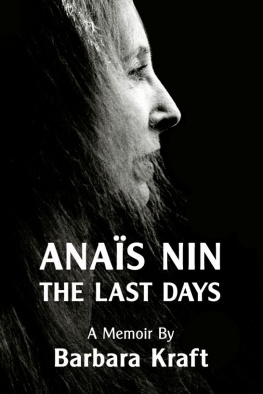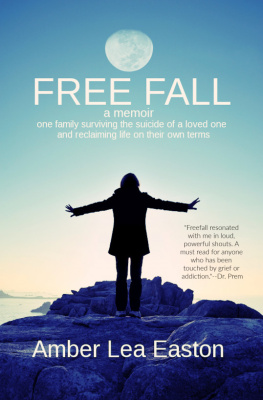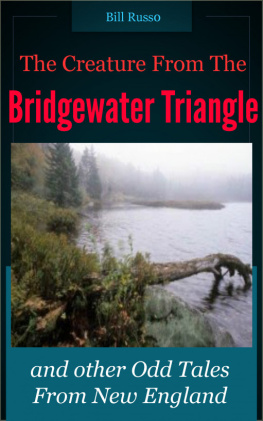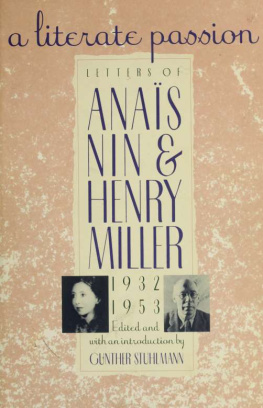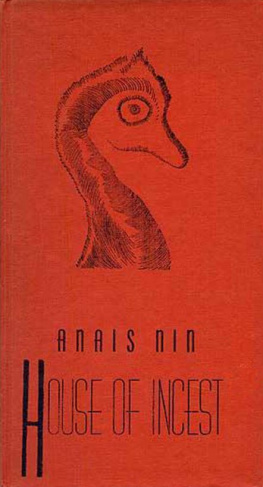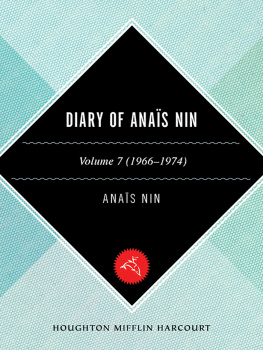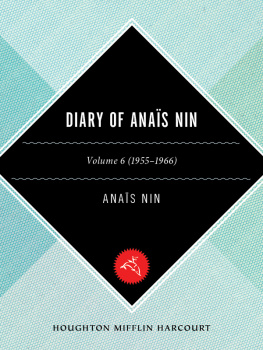ANASNIN:
THE LAST DAYS
A MEMOIR
BY
BARBARA KRAFT
Published by Sky Blue Press at Smashwords
2011 Sky Blue Press
http://www.skybluepress.com
Copyright
Copyright 2011 by Barbara Kraft
An intimate and beautifulportrayal of the final years and painful death of Anas Nin,interweaving their study of writing together, the publication ofKrafts diary, and the breakup of the Kraft marriage. Thiscompelling memoir is honest, critical, and full of perceptiveinsights into the relationships between Nin and her men. Of allthe young women Ive worked with you are the one most like me, Nintold Kraft as she lay dying.Noel Riley Fitch, author of Anas: the Erotic Life of Anas Nin
Because Krafts visits withAnas Nin were so frequent during the last two years of Nins life,Kraft is the most qualified to write this book, which details thegrace with which Nin confronted excruciating pain and the prospectof death from cancer. Kraft does not depict her mentor as a saint,but acknowledges her shortcomings, including possibly dishonestadvice that had unfortunate consequences for Kraft. Anas Nin: The Last Days will appeal to anyone interested in Nin, but also to readersconcerned about relationships between women, the process of dying,and even opera.Benjamin Franklin V, editor of The Portable Anas Nin
Anas Nin died some thirtyyears ago, but this important new memoir takes us back to the womanherself. Krafts moving and deeply personal eyewitness account ofNins final monthsand her gift for candor andself-revelationmakes her book a must-read. Kraft was there, andthe intersection of these two lives makes for sometimesheartbreaking, always lively reading.Chris Freeman, co-editorof The Isherwood Century
All rights reserved. No part of this bookmay be reproduced in any form or by electronic or mechanical means,including information storage and retrieval systems, withoutpermission in writing from the publisher, except by a reviewer whomay quote brief passages in a review.
CONTENTS
PROLOGUE
Romance, literary andhuman, depends on partial or imperfect knowledge.
Shakespeare: The Invention of the Human , Harold Bloom
W hen she died the willow tree outside her window died with her.A few weeks later Rupert cut it down and dug up the stump. He neverreplaced the willow that had wept over the dark green pool,shedding its fragile leaves into the emerald water, while Anas laydying.
The teahouse is gone as well. The one Rupertbuilt to give her a future while she lay dying. It stood for abouta year after she had crossed over, as Rupert put it. Then, whenthe new woman moved in, Rupert took it down. In its place he builta glass and wood room for the new woman, who was working on agraduate thesis exploring diary writing through the ages. It wasquite a beautiful room and overlooked the dark green pool whereAnas had swum daily. Otherwise everything remained the same in thehouse made of glass and rose-colored concrete and rose-rubbed wood,the house Anas called the house of mirrors.
Rupert and the new woman slept in the sametype of bed that Rupert slept in with Anas. It might have been thesame bed, for Rupert was loath to part with anything having to dowith Anas. The bed was low and close to the floor, close to theearth beneath the floor. The new woman and Rupert cooked in thesame greenish glass mosaic-tiled kitchen, ate at the samemosaic-tiled table, the legs of which matched the graining of therose-hued walls. They sat in front of the stone fireplace thatRupert had built with his own hands and that Anas said belonged ina castle. She had found it overwhelming but, not wanting to hurthis feelings and being a believer in the transforming powers of theimagination, she labeled it a fireplace fit for a queen and madeher place in front of it.
That last year Anas sat in front of thefireplace on a garden lounge Rupert brought in from the pool andcovered with soft sheepskin throws. The make-shift lounge attestedto his unwavering conviction that Anas would recover. There shereceived the stream of visitors who found their way down the longdriveway to the tree-enveloped house below. The house that unfoldedlike a Japanese screen into one large room with glass walls facingthe sky, the mountains, and the shining silver lake. The glass wason the west side of the house, and the late afternoon sun inchingits way towards the horizon filled the room with violet rays,turning it into a hothouse. But by then, in that final year of herlife, Anas was always cold and she welcomed the warm embrace ofthe dying day. Only her visitors squirmed in discomfort, the sweatstaining through their clothes, through that turning summer,through that fated fall, through the bondage of her lastwinter.
* * *
Barbarathis is Anas Ninspeaking. I have read your work and I think it is very good. Wehave many affinities. I would like you to come and see me. Thatwas how it began. Three years later, this is how it ended: I canttell the world about my illness, but you can, and I want the worldto know. I want you to write about this.
I have chosen to reveal the intimacies ofAnass last days as I witnessed them so that the story of herdeath is not lost. Everything comes back in the minds eye.Everything comes back in the crucible of the heart. She remains inmy psyche all these years later as the most refined and rarifiedhuman being I have ever encountered. As Marcel Proust observed,People do not die immediately for us, but remain bathed in a sortof aura of lifeit is as though they were traveling abroad.
I met Anas Nin February 8, 1974. I know theexact date because it is the first entry in the diary I began tokeep that day under her guidance
I met with Miss Nin today.It was as if I had always known her, so easy was the dialogue andyet I was conscious of being in the company of a vital presence. Ina strange way I feel as if my life has been a preparation for thismeeting with this singularly uncommon woman.
This situation came aboutthrough the auspices of International College in Los Angeles, atutorial college of scholars and professionals whose roster at thetime included Anas Nin, Buckminster Fuller, and Lawrence Durrell.Two and a half years later, my diary, TheRestless Spirit: Journal of a Gemini, waspublished by Celestial Arts/Les Femmes with a preface byAnas.
From the moment of our initial meeting untilher death in January 1977, I was captivated by Anas, who inspiredintense feelings in everyone she came in contact with. No one wasleft untouched by an encounter with the woman her brother Joaquinreferred to as the steel hummingbird. It was either love or hate.For me it was love at first sight. Nothing I had read about her hadprepared me for this meeting, which was to dramatically change thecourse of my life.
When she answered the door that balmyFebruary afternoon, the kind we Californians are known to bragabout, I was mesmerized by the figure who greeted me. She was HenryMillers Une tre toilique. Dressed in a floor-length, gauzy,cerise-hued Indian gown, the kind popular among the counterculturein those days, but one which she wore regally, she was taller thanI had imagined. Perhaps five feet six inches. Her center-partedhair sat on top of her head like a tiny golden crown. There was nota line on the finely-wrought, mother-of-pearl skin to indicate herseventy-some years. She was poetry embodied with a hauntinglyaccented, slightly husky, flute-like voice. As she led me into thehouse, I followed in her wake feeling awkward and ungainly whileshe seemed to glide over the rose-colored carpet like a swanskimming the surface of still water.
Throughout 1974, we met nearly every week,and during those sessions I would read to her from the diary I waswriting. It was the story of my life as I lived it from day to daybetween our meetings in the house of mirrors overlooking SilverLake. She shared the house with her long-time companion RupertPole, who built the house for her. Anas never articulated exactlywhat her relationship to Pole was, and I never asked. He came andwent, fetched the mail, cleaned the pool, offered a glass of wine.Husband or companion? At the time, it didnt matter, and I paidscant attention to him that first year.
Next page
